Jackie Clay-Atkinson
I’ve had dogs on my various homesteads for more than 50 years now and wouldn’t think of having a dog-free homestead. My dogs have been wonders, having warned me against prowlers and rattlesnakes, run off bears, coyotes, wolves, hawks, and foxes. They’ve helped herd cattle and goats, told me when we had company, pulled sleds, played with my children, helped me hunt birds and rabbits, and killed varmints like ground squirrels and gophers. Heck, they have even brought in firewood! But most of all, a good dog gives us companionship and undying friendship. They’ll cheer you up with their antics and lick away your tears, expecting nothing in return.
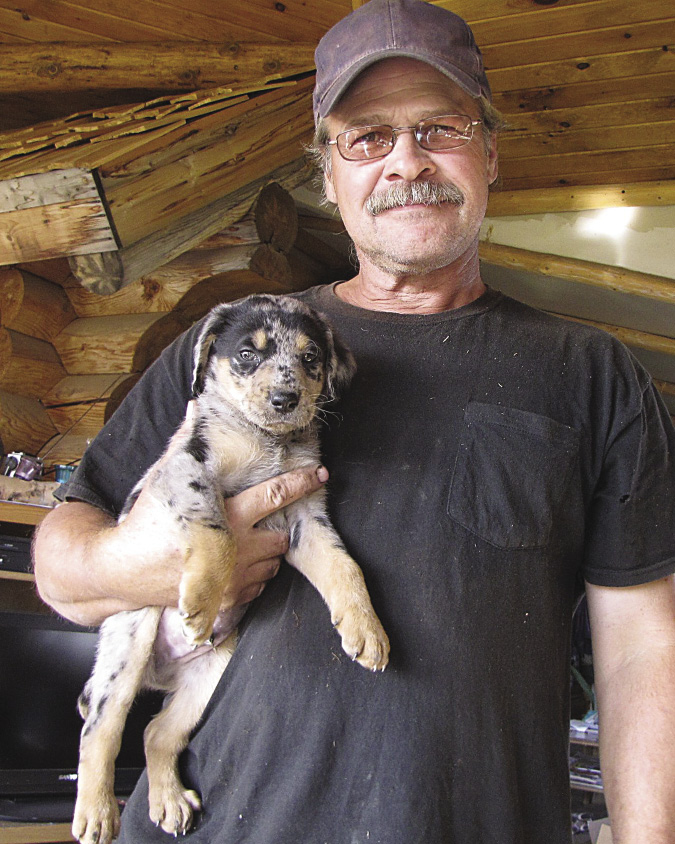
If there’s a cute little puppy in your future, make sure you realize there’s a lifetime commitment of care and training along with him. Here’s Will with our Australian Shepherd mix, Hondo, when he was a puppy.
So what makes a good homestead dog? Well, part of it is choosing a breed or mix of breeds that is known for desirable traits, part is training, and part is interaction with you, his “folks.” I’ll swear our dogs can understand human talk. We’ve had to spell certain words to prevent undue excitement, like g-r-o-u-n-d s-q-u-i-r-r-e-l and m-a-i-l! (Hey, they’re even learning how to spell. Now we have to say dirt-dwelling-rodent!)
Choosing a breed of dog for your homestead
When thinking about getting a dog for your homestead, first give some thought about what you’d like your dog to do. For instance, we’ve always had Labrador Retrievers. But if you have a sheep farm and want a dog to herd sheep, a Lab probably wouldn’t be a good choice as they really aren’t herders. True, our Lab, Spencer, will help herd cattle but herding isn’t bred into a retrieving breed. He barks and tries to help. And he even does a pretty good job of it. But Hondo, our Australian Shepherd mix, is much better at that job. His eyes just glisten when we’re working livestock.
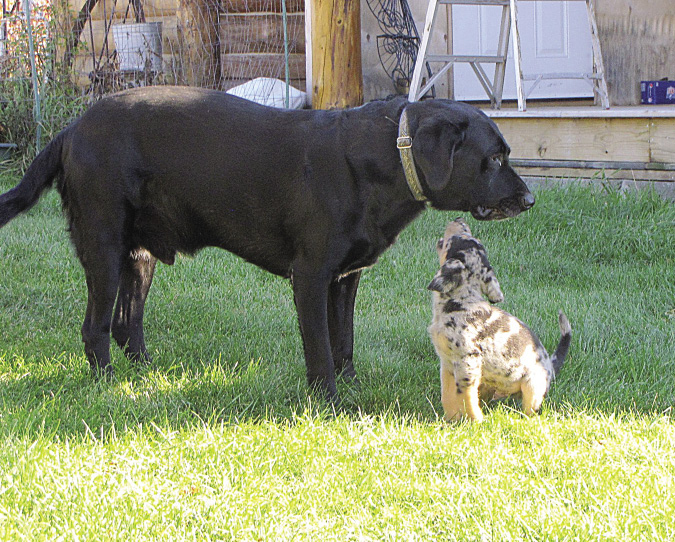
Spencer, a lab, helps “new guy” Hondo learn the ropes.
Hondo, our Australian Shepherd mix, would be a terrible city dog. All day, he watches. He watches birds and runs off ravens and hawks. He watches us and immediately comes with us when we go about homestead chores. He herds; he even herds chickens and turkeys if he thinks they’re in the wrong place. He sits on the porch and watches around for visitors or intruders (two or four-legged). But he would never bite a “friendly” visitor!
If you want a dog to guard your sheep or goats, you can hardly beat a Great Pyrenees. These big, white, shaggy dogs, when raised with the herd, bond with them and will effectively protect them against even larger predators.
Most folks who homestead want a large enough breed of dog to protect both the family and their livestock and poultry. True, a smaller dog may frighten away a prowler but they are just not big enough to be physical protection.
Although I hate to put down certain breeds, as there are always exceptions, some breeds of dogs are just not homestead dogs. For instance, most northern breeds, such as Siberian Huskies and Malamutes, tend to be hard on poultry and livestock, no matter what training you give them. I used to run sled dogs and believe me, I know. No chicken was safe. But then again, I did have Nadia, a wolf-Alaskan husky, who was an exception. She wouldn’t think of chasing a chicken or sheep.
Hounds bay. While I love that deep bell sound in the evening, your nearby neighbors may not. They have been bred to sniff out and chase varmints. Noisily! But they are prone to hunt on their own if left on their own and they certainly are not herd dogs by breeding. But if an important part of your homesteading includes coon or fox hunting, you just plain need a good hound.
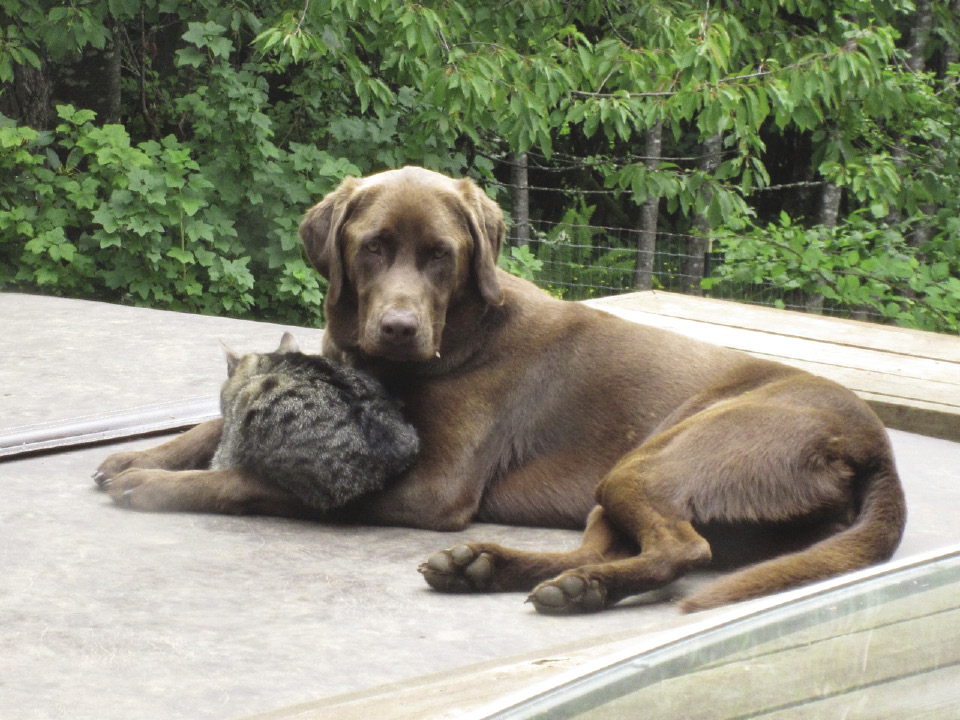
Damon, a 106-pound Chocolate Lab, is a loyal companion on walks in the woods and helps deter animal pests from the Duffy household. He also has three companion cats who like snuggling up with this gentle giant.
I’ve always been partial to Labradors as they are short coated (don’t require lots of grooming like a Collie does), they are intelligent (won’t bite the neighbors’ kids), and are easily trained. My husband, Will, used to have Rottweiler/Labrador crosses for the same reasons. But even Labs and Rotties can have issues. Labs are stubborn and are a bit exuberant until they are two years old (when I say they “find their brain”) and Rotties can be a bit over-protective and stubborn, too. Oh well, they haven’t invented the perfect dog yet. Or person!
While getting a purebred is thought to be best, especially if you have a certain need for a dog, such as a herder or guardian, a dog of mixed breeds can also work out fine, too.
Should I get a pup or an older dog?
Here, I’ll say I much prefer a puppy as they can be trained by you from the get-go and haven’t had time to develop any bad habits you must try to break. And such bad habits as chasing chickens or cars, being aggressive with people, or barking incessantly can be nearly impossible to break in some dogs. Some folks opt for an adult dog, saying they don’t want to mess with the housebreaking thing. One of the most common reasons people get “rid” of a dog is because it won’t stop using the house as its potty.
Ideally, I’ve found that getting a pup at eight weeks or so is perfect. They’re old enough to be away from their mother with no bonding issues and young enough to adapt easily to your family.
It’s a good idea to only buy a puppy from folks who are experienced dog people and only breed a litter or two a year. On purpose. While you don’t need a registered show-bred pup, you want to know the parents of the puppy, hopefully even meet them. In this way you can make sure of temperament, size, and basic conformation. You don’t want a pup from shy or aggressive parents nor from breeders who just accidentally had a litter from who-knows-what father who wandered by. In some areas of the country, puppy mills are common. These are folks who “farm” dogs. They raise as many litters a year as possible from parents of questionable breeding (even when registered), often in horrible, inhumane conditions. It is much better to buy your puppy from a reputable breeder who has concern for the puppies he or she raises.
Make sure you ask the breeder if the pup has had any shots and ask to see the certificate. You’d be surprised at how many people claim their puppies “have had their shots and been wormed,” yet really have not! Find out just what vaccinations have been given and when boosters are due. Just like children, pups need to be protected against common canine diseases such as parvo and distemper. Remember, getting a puppy is a lifetime commitment to love and care. Most of the time it is not expensive but it can be.
Never buy a pup from a litter showing mattery (containing pus) eyes, runny noses, or diarrhea. The are all signs of sickness and should be avoided at all costs. No reputable breeder will sell sick puppies.
Getting ready to bring the pup home
Before you bring your pup home, pick up a dog crate. This is often sold as a Pet Porter and is usually a two-piece plastic crate with vents in the top of the sides and a sturdy wire door in the front. Whoa! Don’t say “I’m not putting my puppy in a cage!” First of all, every dog needs a quiet place to escape too much activity, take a quick nap or be restrained away from company with rough children. The crate is the place.
Housebreaking is so much easier with a crate as puppies do not want to mess in their bed area so they will hold it longer than if they can simply find a corner of the kitchen to go in.
Destructive behavior is avoided by putting the puppy in the crate at night and when you will be away from home for an hour or so. Give him a big bone or chew toy and he’s good to go. No holes in the couch or chewed shoes when you come home.
All of our dogs have been crate trained and we refer to it as their house. The crates contain nice thick bedding and are near the living room so they are near us.
As our dogs are way past puppyhood, we just have one crate in the house now. It’s a just-in-case thing, hardly ever used any more. But so very valuable when the guys were younger. We’d just say “House!” and they’d tear for their crate to get a dog biscuit treat. We sure didn’t have to drag them. They love their house. They never feel like they’re “in jail.”
Get a crate that fits the pup’s size today, plus just a little bit bigger. If you put a small pup of a large breed in a large crate, sometimes housebreaking is harder. When you use a smaller crate for baby pup and then get another large one for when he’s grown, it’ll work much better. You can usually find a small or medium sized used crate by shopping your free shopper, yard sales, or Craigslist online for very little. Ours cost $5 and the second one was given to us.
Buy a pup-sized flat collar and leash so you can begin training him as soon as he comes home. A flat collar is much less hard on a puppy than a narrow collar such as a chain choke collar. You don’t want to cause a pup pain or discomfort.
Vaccinations
If he hasn’t had his “adult” vaccinations yet, contact your veterinarian and if it is appropriate, take him to the vet for his shots before you bring him home. That was Spencer’s first stop. Don’t put it off, even for awhile. My very first pup, a Labrador Retriever, came down with distemper because of that, although we lived in a very rural area with no stray dogs. Sandy was very sick and nearly died. She did pull out of it with much care and medication but she lost the use of her tail due to the disease; she could have died. Just because I didn’t get around to vaccinating her for a few weeks after I’d bought her. Bad mistake!
Recommendations vary depending on the age, breed, and health status of the dog, the potential of the dog to be exposed to the disease, the type of vaccine, and the geographical area where the dog lives or may visit.
A combination vaccine, often called a 5-way vaccine, usually includes adenovirus cough and hepatitis, canine distemper, parainfluenza, and parvovirus. Some combination vaccines may also include leptospirosis (7-way vaccines) and/or coronavirus.
When a puppy is six months old, he should receive a rabies vaccination. Then, as he gets older, booster vaccinations as your veterinarian recommends. This is very important as rabies can be spread by not only wild animals such as bats, skunks, foxes, and raccoons but also dogs and cats. You don’t always know when your dog comes in contact with one of these … or if they may be rabid. And for your family’s safety, as well as your dog’s, please keep your dog properly protected against this horrible disease.
Contact your veterinarian to begin Pup’s vaccination schedule; they will recommend which vaccinations are needed in your area. Don’t forget the boosters which are required.
Many puppies are born with worms and should be wormed before they are weaned. Make sure your pup has either already been wormed by the breeder or take a stool sample to your vet when the pup is taken for his vaccinations. A small bit of fresh stool is examined under a microscope for the presence of worms or intestinal parasites including worms and coccidia, a common protozoan intestinal parasite, especially in pups.
If a pup has worms or other intestinal parasites, a simple oral medication will quickly take care of that. It’s a good idea to repeat in 10 days to interrupt the parasite’s breeding cycle as most medications do not kill the eggs present.
Find out what the pups were eating at the breeders and buy a bag of the same brand dog food so you don’t change the diet abruptly. This can cause diarrhea. If you want to change it because it’s hard to find or you have a favorite brand, do it slowly to avoid digestive upsets.
The first days home
Remember your puppy is used to having his mom and brothers and sisters around him constantly. Without them, he’ll be scared and lonely. He’ll whine and probably howl. This is normal, especially the first night home when it suddenly gets real quiet in the house. Putting a radio nearby and turning it down low will help.
Pups go to the bathroom often. The three most urgent times are right after eating, after playing, and when getting up in the morning. If you take Pup outside at those times and let him sniff around in the weeds, he’ll usually quickly go. It helps if you say “Go potty” or some such command. They catch on very quickly.
But accidents can happen. I just take the pup by the scruff of the neck, point them at the mess and say “No!” Then take them immediately outside to their potty spot. Again, they catch on very quickly. If you don’t get lazy about pottying the pup, housebreaking will be pretty much done in less than a week. Dogs aren’t hard to housebreak; people are poor instructors. Clean up any messes with soap and water so there is no lingering odor to attract them to make a second mistake. You’ll usually have to get up once during the night to potty Pup until he’s about 10 weeks old or so. By then most pups can hold it overnight. But get up early and take him outside first thing.
Young pups have a hard time eating dry dog food. So for a few weeks, you may have to moisten the dry food with warm water. As the pup grows, this can be stopped. Eating dry food as opposed to canned food is much better for their health, especially their dental health. Dry food does much to keep the tartar scraped off their teeth, ensuring fewer gum diseases later on.
Always have a few chew toys around for the pup that are “his.” This quickly teaches them to chew their big bones and toys, not your favorite shoes or the couch legs. Even now, our big, older dogs have their beloved “babies” (stuffed animals). True, when they were young they delighted in de-stuffing them. But they soon either outgrew this or decided that when Mom (me) found a de-stuffed baby, that baby ended up being tossed into the wood stove. Now they have a plastic tote full of the “babies” I buy for a quarter each at the local Thrift Store and they cherish them, carrying them around to show anyone who will look.
Training your homestead dog
As soon as Pup comes home, give him a name and use it frequently. It’s amazing how quickly even a young puppy will learn its name. Pick a short, snappy name that doesn’t sound like a command. Clown sounds too much like the command “down.” You should learn to say the pup’s name when giving a command. For instance, “Hondo, sit!” The reason for this is saying the pup’s name calls attention. Then he’s ready to listen to the rest of the sentence.
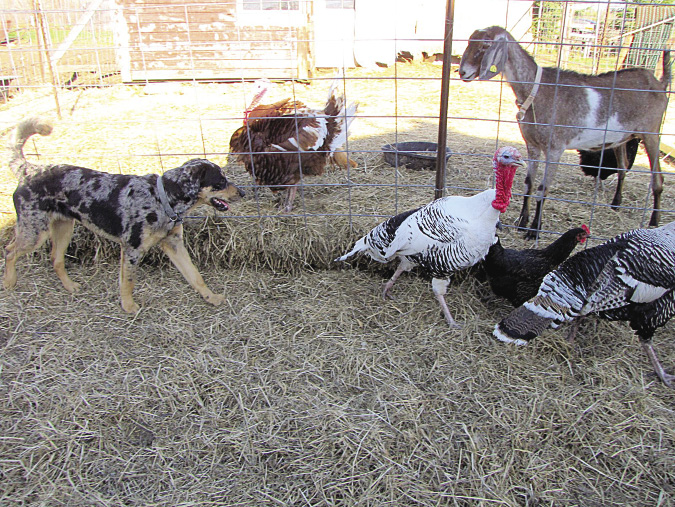
Because Hondo is half Australian Shepherd, herding is in his blood. He even herds turkeys and chickens, but he is
never allowed to play rough with them.
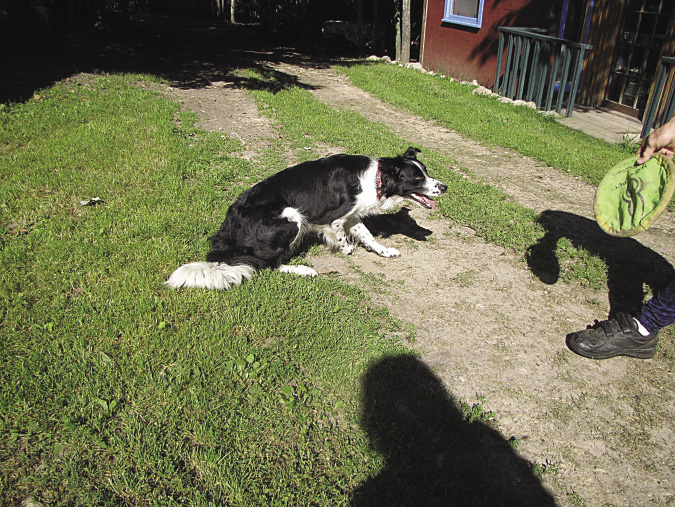
We teach our dogs to walk on a leash and heel at a very young age. It might be “cute” to have a little puppy walking ahead of you, straining on the leash in excitement. But it’s not so cute when that puppy grows up to be a 90-pound dog. Keeping a dog at your side not only makes walking him easier but it also keeps both you and him safer. There’s no dashing out in front of farm machinery or a truck or having the excited dog suddenly cross in front of you, making you fall on the ice.
To teach Pup to heel, just put his leash on often and take him out for a walk. Gently, pull him back to walk at your left side and begin walking at an easy pace for him. Say “Pup, heel!” in a friendly tone of voice. Remember while dog training that you’re not a Storm Trooper! Rewards in the form of praise, a dog biscuit, and petting get far better results than “making the dog mind.”
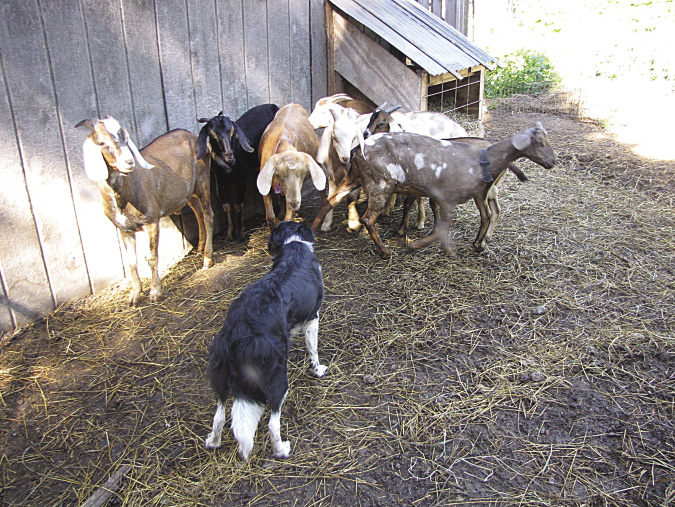
Midge, a Border Collie, is a great help herding my friend Dara’s goats. Here, she holds the goats bunched while Dara closes a gate.
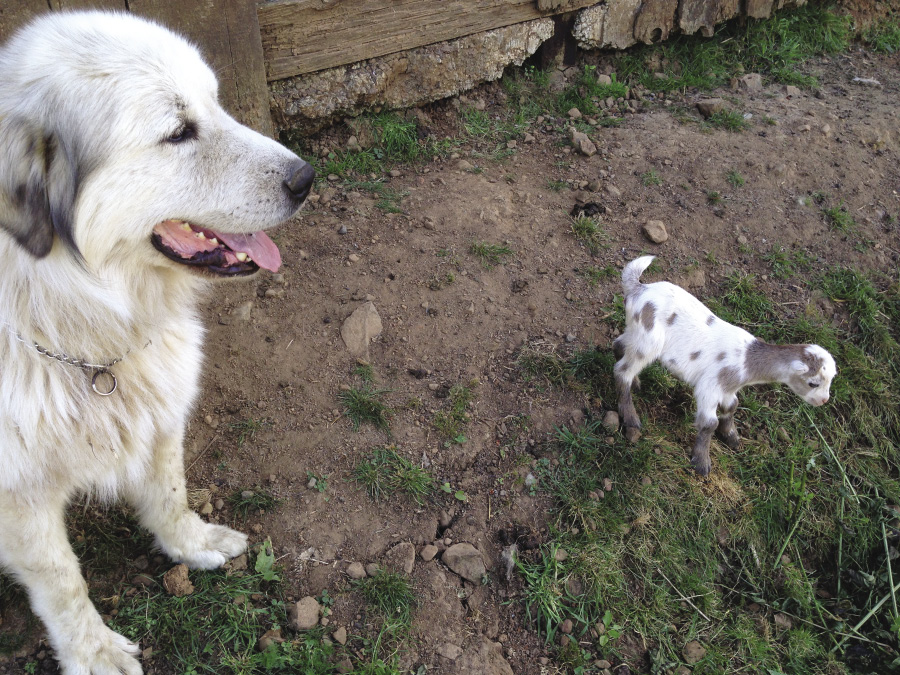
Hanuman, a pure Great Pyrenees, is another large dog, but he gently protects even his tiniest flock members. He lives full-time with the goats on editor Annie Tuttle’s farm, but is still expected to behave like a gentleman around family members and friends. He keeps coyotes at bay, and even chases hawks and crows away from the chicken coop.
Walk a few steps and if Pup minds, stop and praise him and even give him a small treat. Repeat this often and you’ll soon be able to do away with the leash. Use a leash if you ever take Pup to the vet, a strange place, or in heavy traffic. Just in case.
We also use hand signals. When we say “Pup, heel.” we also slap the side of our leg. Soon you can do away with the voice command.
Once Pup is heeling well, begin teaching him to sit when you stop. This is usually very easy to teach. When you stop, say “Pup, sit!” and gently pull up on the leash and push his butt down with your other hand. When he obeys, praise and a biscuit please.
Work him at heeling, then stopping to sit. This usually only takes a few days’ practice. Like heeling, we use a hand signal. What we use is pointing a finger, then dipping it down. Basically, “you, sit.” It’s amazing how quickly they catch on.
We usually teach heeling and sitting first as that’s learned while taking Pup on potty breaks.
Next comes the command “COME!” In a safe spot such as a fenced yard, take Pup off the leash and let him snoop away from you a bit. Then, in a happy voice, say “Pup, come!” or “Pup, come here!” You may have to repeat a few times but if you give plenty of praise and a biscuit, soon he’ll come running when you call. If he has a bit of trouble learning this, use a lightweight rope of about 12 feet or so. Let him wander away, then call him, tugging gently on the rope, reeling him in a bit if needed. Our hand signal for “come” is simply snapping your fingers.
A very handy command is “STOP!” This can be a herding command or a safety one. For instance, you see a rattlesnake in the path and Pup is coming. “Pup, stop!” may save his life.
First teach him “come.” Then as he comes, say “Pup, stop!” and hold up your hand in a stop motion. It takes a bit of work but soon Pup will be stopping on command like a trooper. Once he stops, let him stand a moment, then say “Pup, come!” Remember the rewards while teaching him anything new. Later on, simply making a fuss over him and petting are all that is needed. Our “old timers” are so practiced, we just say “Good boy!” and they’re happy.
Teaching the word “No!” is very important. No means stop what you’re doing immediately. This can be barking, growling, chewing, digging, or playing too roughly. Here, the punishment for disobedience should fit the “crime.” Just repeating “Pup, no!” is sufficient if Pup is barking. But growling at a family member needs stricter punishment. I take Pup’s scruff over his neck and shove his head to the ground and hold him there, repeating “No! Bad dog!” This punishment is what mother dogs do, along with biting the pup, which I don’t do. He understands it. Hitting is not an appropriate punishment for puppies. There should be no reward for “No.”
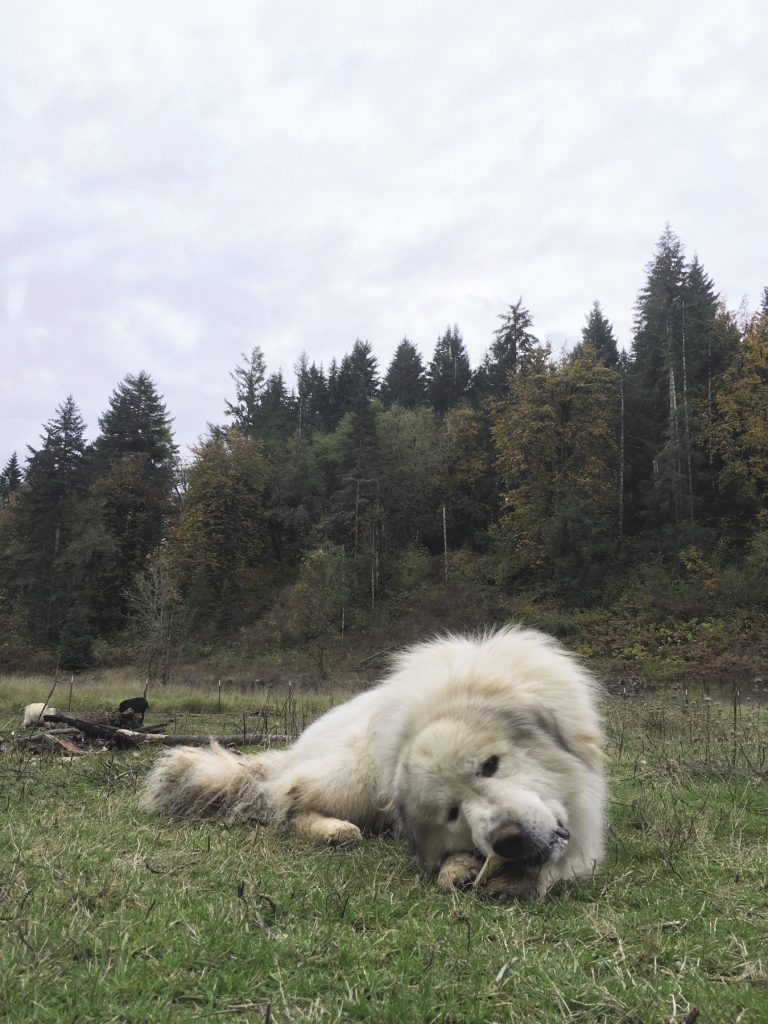
Hanuman spends his days laying around and his nights running along the perimeter fence and barking. Since guardian dogs like Great Pyrenees tend to bark a lot, you’ll need to give consideration to how near any neighbors are and your own tolerance for night barking.They also have a reputation for wandering.
Likewise, teach Pup at a very young age chickens and small livestock are not for chasing or playing with. First a puppy will play with chickens, loving it when they squawk and flap. But soon, playing entails pulling feathers and jumping on the unfortunate birds. And pretty soon, you have a dead chicken.
At a very young age, go out every time your pup does and the first time he shows interest in chickens, say “Pup, no!” in a very strict voice and call him away. When our Labrador, Spencer, was a youngster, he was especially hard to stop chasing chickens. He never killed one but he tried to chase them. I lost track of the times I pinned his head to the ground by the scruff of his neck and scolded him. But finally he got it through his head that he was not to chase chickens.
A funny thing, though, a couple years later, Will and I took him grouse hunting. He loved leaping through the woods, sniffing for grouse. But when he’d flush one, he’d quickly look away from it, turning his head completely away from the bird. It was like he was saying “Hey, I did not chase that chicken!”
Another good command to teach Pup is to lie down. You can use this while walking him (you want to visit with a neighbor) or in the house when he is getting pesky. Or you can have him lie down to block a gate while working with livestock.
To teach this, first say “Pup, sit.” Praise him when he obeys. Then say “Pup, lie down.” and press down on the top of his shoulders. When he obeys, praise him enthusiastically and give him a treat. Soon he will catch on and you can just give the command. We vary it; sometimes saying “Pup, lie down.” while he is coming toward you. Or “Pup, lie down.” when he is playing in the living room.” The hand signal we use for this is a flat hand, held out in front of you, motioning downward. First we use the voice command and the hand command, then just the hand command.
You can use a combination of commands if the situation warrants it. For instance Pup is off leash in the pasture. You say “Pup, come.” then the hand signal, “Stop!” and the hand signal “Down.”
Next is the command “STAY.” Sometimes you really need your dog to stay where you put him. This may be going across the road to get the mail. (You don’t want him to cross the road and get hit.) or you may want him to guard a gate while you sort livestock in a pen. To teach him this, either first give the command “Pup, sit!” or “Pup, down!” When he obeys, praise him. Then say “Pup, stay!” and wait a few minutes, then go to him and praise him, giving him a treat. At first he may be confused but soon you will be able to have him stay for a longer and longer period of time. The hand signal we use is a downward pointing flat hand, motioning him away. This varies from “stop” as the stop signal has the flat hand pointing up like a traffic cop saying stop.
Dogs are like children. They respond to love and rewards a whole lot better than yelling and hitting. Actually, we treat our dogs like they are children. We love them, yet expect them to mind, or at least give it a try. But remember, dogs are not children. They are dogs and you have to understand they are dogs, think like dogs, and behave like dogs. You need to earn their respect. Not by beating or hitting and yelling at them, but by being constantly firm when needed and generous with praise when earned. In that way you remain the alpha dog in their “pack.”
Teach your very young puppy to enjoy riding in a car or truck. Don’t put Pup in the back of a pickup. It’s very dangerous; many dogs are killed when they either jump or fall out of the truck in traffic or even on a country road. At first, only take Pup for short rides. If he seems nervous, hold him on your lap and pet him. Soon he won’t mind as much. Increase the length of his rides. If you do this often, he’ll soon enjoy going with you, no matter how long the trip is. Car sickness is usually only seen in dogs that don’t “get out” often.
Keep up the “riding in the car” training. When Hondo was very young, we had to take him and Spencer on a 1,000-mile ride to Will’s daughter’s house in Illinois. He made the trip like a trooper. But we kind of let the car riding training lapse until winter when Will decided Hondo would like riding in the snow plow truck, clearing the driveway. Oh oh. Hondo got car sick and drooled, threw up, and shook all over. It took Will several weeks of retraining. First he would just catch Hondo (yes, he had to run him down in the house!), then load him and Spencer in the car and just let it sit still, not running. Even then, Hondo drooled. But after awhile, he didn’t drool so Will drove the car around the circle driveway, then stopped, giving both dogs biscuits. (Spencer made out like a bandit here as he already loved to ride!) Finally, Will didn’t have to chase Hondo down, but could just say “Load up!” and both dogs jumped happily in the car. Then he drove the mile down to our mailbox and back. It wasn’t long before Hondo jumped up and down if Will said “Do you want to go get the mail?” Now he rides happily in the truck or car. No drooling, no vomiting. But it would have been much easier to keep up the “riding in the car” training.
We use the command “Load up” when we’re ready to have the dogs go with us. And we’ve got them trained to sit in the back of the car or in the front seat, wearing a seat belt. (Hey, they’re big dogs and the safety devices fit them.)
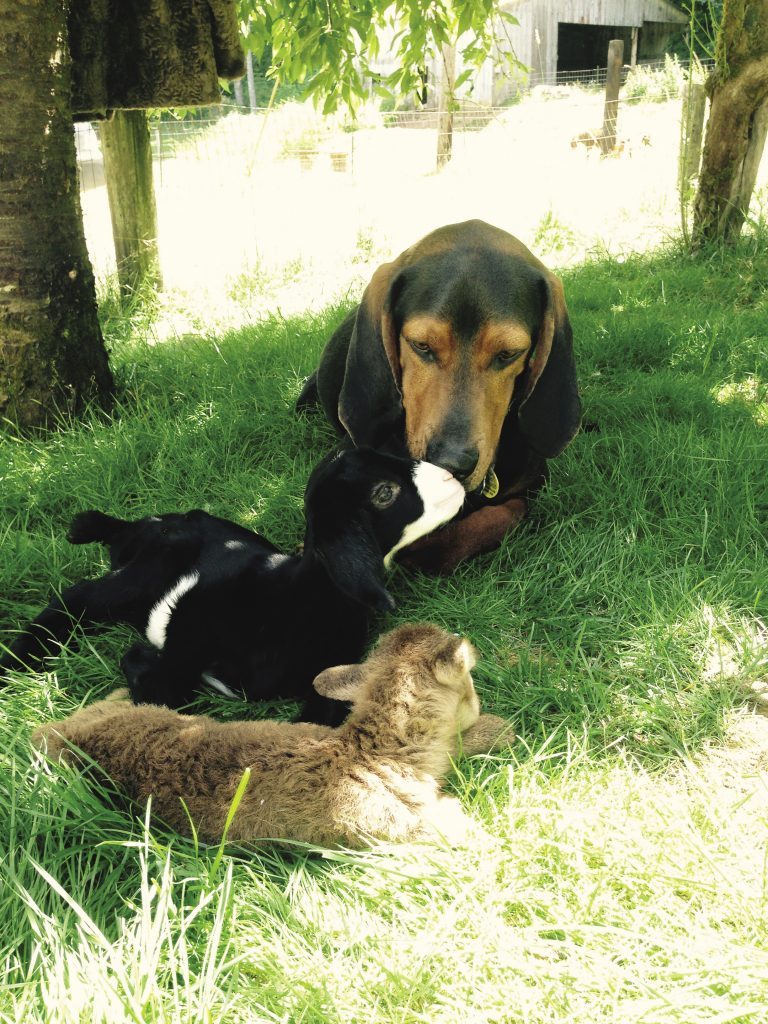
Cletus, a Black and Tan Coonhound, always loved the babies and was an exceptionally gentle kid’s dog. Hounds like to take themselves on tours of the countryside, however.
It’s actually safest to put your dog’s crate in the back and have him “load up” into that. In case of an accident, he’s much safer inside the crate than loose in the back seat. With the wire door facing the back of the vehicle, he can still see out and watch things go by.
Teach your dog to stay home or stay with you when you go about your homestead business, whether it’s in the hayfield or woods. Many, many dogs are injured or killed when they stray off their own property, either just plain snooping around or chasing deer. When we go out with the young dogs, we keep them within eyesight. Whenever they get a bit far away, we quickly call them back. We do not let our young dogs out in the yard by themselves, unsupervised. Although we are over a mile from the road, there is too much of a chance something could happen to them if they stray away from the yard. We do have wolves which will happily kill and eat a dog, especially when they are wandering in the woods alone. And your neighbor will not long be a good neighbor if your dog makes a pest of himself by going over there without you, especially if he is chasing their chickens or killing their sheep. Know where your dog is all the time. Likewise, we bring our dogs into the house at night time. They still alert us to any predators or possible prowlers, yet stay safe from roaming and wolf packs.
It’s said that neutering your dog will make him or her stay home. Well, yes and no. Yes, a dog in heat or male smelling a female in heat half a mile off will often cause them to roam. So if you have a female it is best to have her spayed, even if you live quite a ways from the neighboring dogs. Remember, not all owners will keep track of their male dogs, insisting they stay home. Many just “have” a dog and don’t bother training it. Thousands of unplanned litters happen each year because wandering males breed unspayed females.
If you have a male homestead dog and have relatively close neighbors, it would be wise to have your male altered. It will help keep wandering ideas from his head, due to hormones. We have not had our males altered as our nearest neighbor is over a mile away and he does not have dogs. And we know where our dogs are at all times. They are trained to stay home unless they go with us.
If you plan on training your homestead dog to herd sheep or other livestock, I’d recommend picking up a good book on that subject as herding is a very specific training which requires more information than I can give you in this article. Likewise for livestock protection dogs such as Great Pyrenees, which live with their flocks. There are also many online tutorials on training these dogs so it makes the job so much easier and more fun.
Dogs are smart
One thing we’ve learned through the years of interaction with our dogs is that dogs are smart. Period! No matter what some folks say, they use their brains to the max. For instance, just yesterday, while showing off our north garden to friends with our dogs, Spencer and Hondo, along in the pasture, suddenly here comes our mule, Domino, at a full run. She absolutely hates anything canine and figures all dogs are wolves. She charges them, forefeet and teeth bared. And poor Spencer! He’s arthritic and overweight. He saw Domino coming and headed for the fence. Too slowly! Will hollered at Domino and we were waiting horrified, to see Spencer trampled. A bad moment for sure. But suddenly, Hondo streaked across the pasture, tearing between Domino and Spencer. He distracted Domino, giving poor Spencer time to reach the cover of the trees. Then he “played” with Domino, leading her back, way back toward the grazing horses, ducking bared teeth and flying feet easily. He saved poor Spencer’s life. And we have absolutely no doubt he knew just what he was doing.
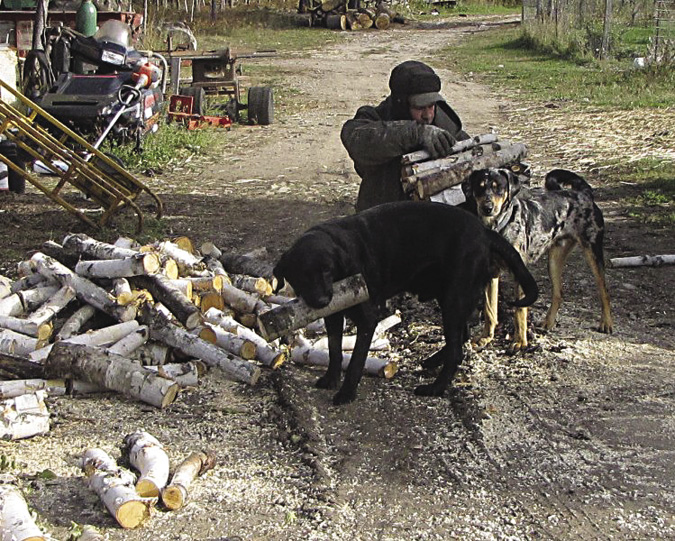
With very little training, Spencer learned to bring in firewood. He even drops it in the living room wood box!
Then, how about Spencer? Not only has he learned to carry in firewood, but also climb tall ladders. Okay, the last he kind of gave up when he got pudgy. When David and Will were putting the roofing on the storage barn, they had an extension ladder up against the roof. Pretty soon, Spencer, who was feeling kind of left out, climbed all the way up the ladder and hopped onto the roof. I’ll admit, Will had to carry him back down the ladder when they were finished.
Remember, through your months and years with your dog that it takes a long time for a dog to be completely trained. Dogs are just like children; some learn faster than others and some are more reliably obedient than others. It takes time and repetition on your part to help your pup learn faster. Don’t expect him to be a robot at three months of age. It is not going to happen! But like anything, the more time and work you put into his training, the better your results will be.
No doubt about it, dogs are smart. And with such a smart partner on your homestead, you can’t help but enjoy it more with such a good, faithful canine alongside to help, protect, and entertain you.
Make your own dog biscuits
You can make your own dog treats instead of buying them at the store. It only makes sense for people who want to know just what’s in those treats. Homemade biscuits contain no preservatives or chemicals. And the truth is they only take about half an hour to make a nice batch. This is a fun project to make with the kids.
Bacon flavored treats
- 1½ cups whole wheat flour
- ½ cup powdered milk
- 1 tsp. garlic powder
- 1 Tbsp. wheat germ
- 1 tsp. beef bouillon granules
- ⅓ cup bacon grease
- 1 egg
- ½ cup ice water
Preheat oven to 350° F. In a medium bowl, stir together the flour, powdered milk, garlic powder, wheat germ, and beef bouillon granules. Stir in the bacon grease and egg. Add ice water one tablespoon at a time until dough is wet enough to stick together. On a lightly floured surface, roll the dough out to ½ inch thickness and cut with cookie cutters. Place biscuits 1 inch apart onto an ungreased baking sheet. Bake for 25 to 30 minutes in the preheated oven until firm. Cool before serving.
Peanut butter dog bones
- 2 cups whole wheat or white flour
- 1 cup rolled oats, regular or quick
- 1 Tbsp. dried parsley or 2 Tbsp. chopped fresh parsley (optional)
- ½ cup nonfat dry milk
- ½ tsp. salt
- 2 large eggs
- 1 cup peanut butter, crunchy or plain
- ½ cup + 1 Tbsp. cold water (sometimes a bit more; enough to make an easily handled dough
Preheat oven to 300° F. Lightly grease cookie sheets or line with parchment.
Mix dry ingredients well, then mix in eggs, peanut butter, and water. Mix well until it forms a dough. Don’t worry, it’ll be lumpy and ugly. On a lightly floured surface, roll the dough out to ½ inch thickness and cut with cookie cutters. Place biscuits one inch apart onto an ungreased baking sheet. Bake for 25 to 30 minutes in the preheated oven, until firm. Cool before serving.
You can store cooled dog biscuits in an airtight container on the counter for weeks.
I finally broke down and bought a dog-bone shaped cookie cutter. It keeps my husband, Will, from thinking the dog biscuits are cookies or crackers and eating them!
Dog treats are very easy and fun to make. Your dog will love them and they’re good for him too. Have fun!

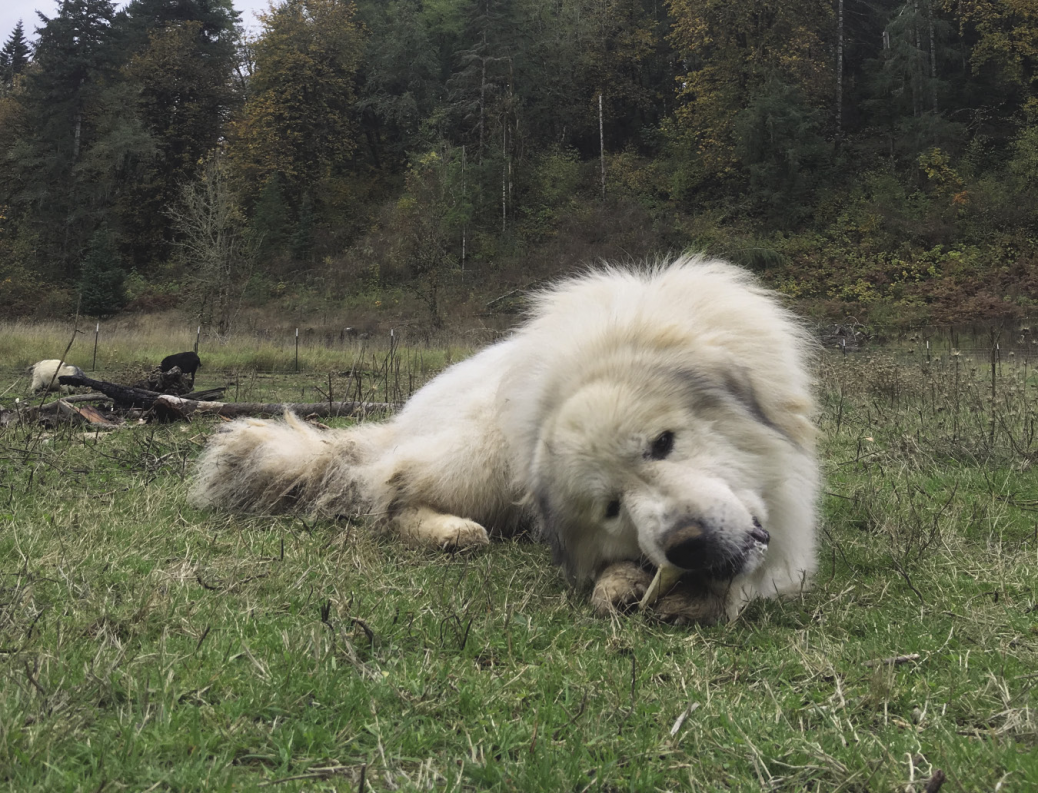
Hello and thank you so much for taking time to share your experience and expertise. I am planning to begin a homestead in the near future, allowing time to learn and put my plan in place. I’ve had a wonderful 3 year old female hound (possibly Ridgeback) pit mix since adopting her from a shelter when she was 10 1/2 weeks old. Bella has been my lifesaver! She’s been trained using lots of praise and some treats. However, I didn’t stay on top of it as I should have, and now I have to train her as an adult dog, especially utilizing the information you shared regarding homestead specific training. Bella is extremely strong and very intelligent. I want to train her properly and successfully to live with me on our homestead when it’s completed. Do you have any thoughts about the best way to train her since she’s 3 years old.